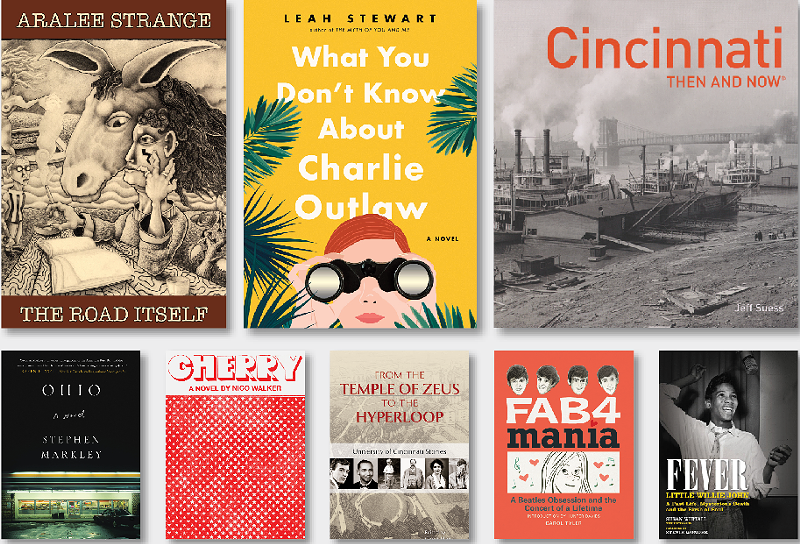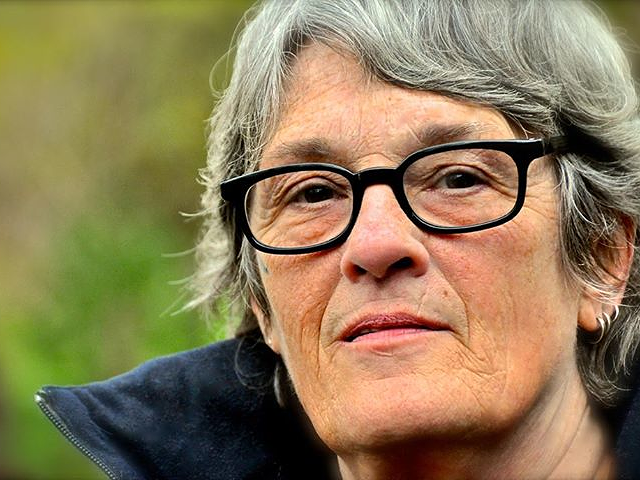A “regional book” can be defined broadly (the author is from Cleveland) or narrowly (it could be about University of Cincinnati’s history). As a result, in any given year there are many to choose from. Thus, this survey of 2018’s most notable regional books is necessarily selective.
To me, the most significant 2018 book of regional interest is a collection of poetry. That’s not only because of what it is, but also because of whose writing it features. The Road Itself (Dos Madres Press) is an overview of the poetry of Aralee Strange, who was very much a part of Cincinnati’s arts community for the approximately 20 years she lived here. Although she died in 2013, she has continued to be a source of inspiration for those who knew her.
After time spent in Atlanta, Birmingham, Ala., Cambridge, Mass. and New York City, Strange lived in Over-the-Rhine and Adams County, Ohio from the ’80s through the ’00s. She then moved to Athens in her home state of Georgia, where she died.
At a time when OTR’s Main Street had urban blight (but also a developing Bohemianism), Strange found strong, vivid source material there. She wrote the poems “dr. pain on main,” “dr. pain’s downtown ramble bone” and “dr. pain’s main street remedy,” which are all included in The Road Itself. As she was close with visual artists, the book features cover art by Jay Bolotin — also a Cincinnatian — and contributions from others.
There is a book release celebration on Tuesday, Nov. 27, at Over-the-Rhine’s Woodward Theater, presented by Word of Mouth Cincinnati. Strange’s poems will be read by Pauletta Hansel, Matt Hart, Jim Palmarini, Stacy Sims, Mark Flanigan, Steven Paul Lansky, Ali Edwards, Richard Hague, Michael Henson, Heidi Joffe, John Ray and Michael Burnham; the band Ruby Vileos will reunite and play in tribute to Strange. The event starts at 7 p.m. and is free.
Moving on to regional novels, there were some that attracted national attention in 2018. Leah Stewart, a creative writing professor and chair of the Creating Writing: Fiction program at University of Cincinnati, published What You Don’t Know About Charlie Outlaw (G.P. Putnam’s Sons) in spring. It’s the story of an actor who gets kidnapped when he leaves the U.S. for a secluded island. CityBeat called it “a carefully crafted meditation on modern identity and the divisions between our private and public selves” and Entertainment Weekly listed it as one of 10 books to read if you love A Star Is Born.
The opioid crisis factors into two attention-grabbing regional novels, both debuts by relatively new writers.
Stephen Markley’s Ohio (Simon & Schuster) is set in the fictional town of New Canaan and concerns four former classmates experiencing the Rust Belt’s decay. NPR called it “a sprawling, beautiful novel that explores the aftermath of the Great Recession and the wars in Iraq and Afghanistan, and a powerful look at the tenuous bonds that hold people together at their best and at their worst.”
Nico Walker’s Cherry (Alfred A. Knopf) just landed on The New York Times’ list of 2018’s 100 Best Books. A literary exercise in tough, violent noir, it follows a damaged, dope-sick Iraqi War medic who returns to Cleveland and robs banks. It’s also semi-autobiographical — Walker wrote it while serving time for bank robbery at a federal prison in Ashland, Ky.
In non-fiction, the University of Cincinnati Press is preparing for the school’s 2019 bicentennial with a collection of fascinating, thoughtfully written essays about its history. From the Temple of Zeus to the Hyperloop: University of Cincinnati Stories, was edited by Greg Hand, UC’s former vice president for public relations. And Dylan Taylor-Lehman looks at the colorful task of governing in Yellow Springs, Ohio — home of the progressive Antioch College — in Dance of the Trustees: On the Astonishing Concerns of a Small Ohio Township (The Ohio State University Press).
Cincinnati historian/writer Jeff Suess released a lovely book with great photographs called Cincinnati: Then and Now (Pavilion Books). You may not be pleased when you see what now stands where the Shubert Theater or the Price Hill Incline were located, but other landmarks — like Union Terminal and the Roebling Suspension Bridge — have aged very well.
This year’s Terracotta Army: Legacy of the First Emperor of China was the highest-attended ticketed exhibition at Cincinnati Art Museum since ’82-’83’s Treasures of the Tower of London, and you can relive it with the hardbound catalog, authored by Li Jian and Hou-mei Sung and published by the Virginia Museum of Fine Arts.
It’s been a busy year for books about music history and the music business. Hamilton, Ohio-based music writer Randy McNutt has just self-published his latest work, Spinning the Groove: An A-Z Guide to the Lingo and Legacy of the Old Record Business. Want to know what “sleepersville” or “glue job” meant? The definitions of those terms and many others are here.
Fran Belkin, whose husband Jules (with his brother Mike) was probably Ohio’s most important concert promoter during the Rock era, has written about their many memorable shows in her self-published Rock This Town! Backstage in Cleveland: Stories you never heard & swag you never saw. Although Belkin produced Cincinnati shows, the book is focused on northeastern Ohio concerts. Among other things, Belkin Productions booked David Bowie’s first U.S. concert (in 1972 at Cleveland’s Music Hall) and filled the city’s 78,000-capacity Memorial Stadium for The Rolling Stones.
Cincinnati-based cartoonist Carol Tyler’s Fab4 Mania: A Beatles Obsession and the Concert of a Lifetime (Fantagraphics Books), is a poignant graphic novel based on a diary-like book she made at age 13 about wanting to see the Beatles play a concert near her Chicago home in 1965.
And while Susan Whitall’s Fever: Little Willie John — A Fast Life, Mysterious Death and the Birth of Soul (Titan Books) isn’t new (it was published in 2011), it is newly relevant because the character of John — a 1950s-era King Records singer who first recorded the classic “Fever” — plays such an important part in Cincinnati Playhouse’s current Cincinnati King. Whitall’s book offers a chance to learn more about John.






